How Have Straight Lines and Angles Influenced Ancient Art
As long as nosotros humans have been able to use our hands, we have been creating art. From early cave paintings to the ceiling of the Sistine Chapel, human artistic expression can tell us a lot about the lives of the people who create it. To fully appreciate the cultural, social, and historical significance of dissimilar artworks, you demand to be aware of the broad art history timeline. This article presents an overview of many significant eras of fine art cosmos and the historical contexts out of which they have risen.
Table of Contents
- 1 Fine art Eras: Where to Begin?
- 2 A Cursory Overview of the Fine art Periods Timeline
- 3 A Comprehensive Fine art Movement Timeline
- 3.1 The Romanesque Menses (g-1300): Sharing Information Through Fine art
- iii.2 The Gothic Era (1100-1500): Freedom and Fear Come Together
- 3.three The Renaissance Era (1420-1520): The Reawakening of an Fine art Era That Never Really Existed
- 3.4 Mannerism (1520-1600): A Window into the Future of Kitsch
- three.v The Baroque Era (1590-1760): The Glorification of Power and the Deception of the Eye
- iii.vi The Rococo Art Period (1725-1780): Light and Airy, a French Fancy
- iii.7 Classicism (1770-1840): Throwing Information technology Dorsum to Classic Times
- three.eight Romanticism (1790-1850): A Break from the Severity of it All
- 3.9 Realism (1850-1925): Objectivity over Subjectivity
- three.ten Impressionism (1850-1895): Heralding the Era of Modern Fine art
- 3.11 Symbolism (1890-1920): At that place is Ever More than Meets the Eye
- three.12 Fine art Nouveau (1890-1910): The Pure Gilded of Gustav Klimt
- 3.13 Expressionism (1890-1914): Bringing a Political Edge to the Debate
- 3.14 Cubism (1906-1914): Breaking Things Apart and Putting Them Dorsum Together Once again
- 3.15 Futurism (1909-1945): Artistic Anarchism
- 3.16 Dadaism (1912-1920): The True Reality That Life is Nonsense
- 3.17 Surrealism (1920-1930): Things Just Get More Bizzare
- three.18 The New Objectivity (1925-1965): Cold and Technical
- iii.xix Abstruse Expressionism (1948-1962): Stepping Abroad from Europe
- iii.20 Pop-Art (1955-1969): Art is Everything
- three.21 Neo-Expressionism (1980-1989): Modern Art
Art Eras: Where to Begin?
As long as humankind has been conscious of itself, it has been creating art to represent this self. The earliest cave paintings that we are aware of were created roughly 40,000 years ago. We have institute paintings and drawings of act from the Paleolithic Era nether rocks and in caves. We cannot truly know the reason why these early humans began to produce art. Perhaps painting and cartoon were a way to record their lived experiences, to tell stories to young children, or to pass down wisdom from ane generation to the next.
 These prehistoric rock paintings are in Manda Guéli Cavern in the Ennedi Mountains, Chad, Central Africa. Camels have been painted over earlier images of cattle, perhaps reflecting climatic changes;David Stanley from Nanaimo, Canada, CC By 2.0, via Wikimedia Commons
These prehistoric rock paintings are in Manda Guéli Cavern in the Ennedi Mountains, Chad, Central Africa. Camels have been painted over earlier images of cattle, perhaps reflecting climatic changes;David Stanley from Nanaimo, Canada, CC By 2.0, via Wikimedia Commons
Although we take these exquisite examples of early artistic expression, the official history of fine art periods only begins with the Romanesque Era. Official fine art era timelines do not include cavern paintings, sculptures, and other works of art from the stone age or the beautiful frescos produced in Egypt and Crete in effectually 2000 BC. The reason backside this conclusion is that these early eras of creative expression were spring to a relatively small geographical infinite. The official art eras that nosotros will exist discussing today, in dissimilarity, span beyond many countries, frequently all of Europe and sometimes N and South America.
Despite their lack of official recognition, these earliest examples of homo artistic flair heighten a lot of interesting questions. Why is it that the animals depicted in cave paintings are so much more than realistic and bright than the animals represented in subsequently eras?
This article hopes to give yous some insight into the ever-changing artistic style of the human being creative mind as we explore the complexities of the different art periods.
A Brief Overview of the Art Periods Timeline
As with many areas of man history, it is incommunicable to delineate the different art periods with precision. The dates presented in the brackets below are approximations based on the progression of each movement across several countries. Many of the art periods overlap considerably, with some of the more recent eras occurring at the same time. Some eras last for a few thousand years while others span less than 10. Fine art is a continuous process of exploration, where more than contempo periods grow out of existing ones.
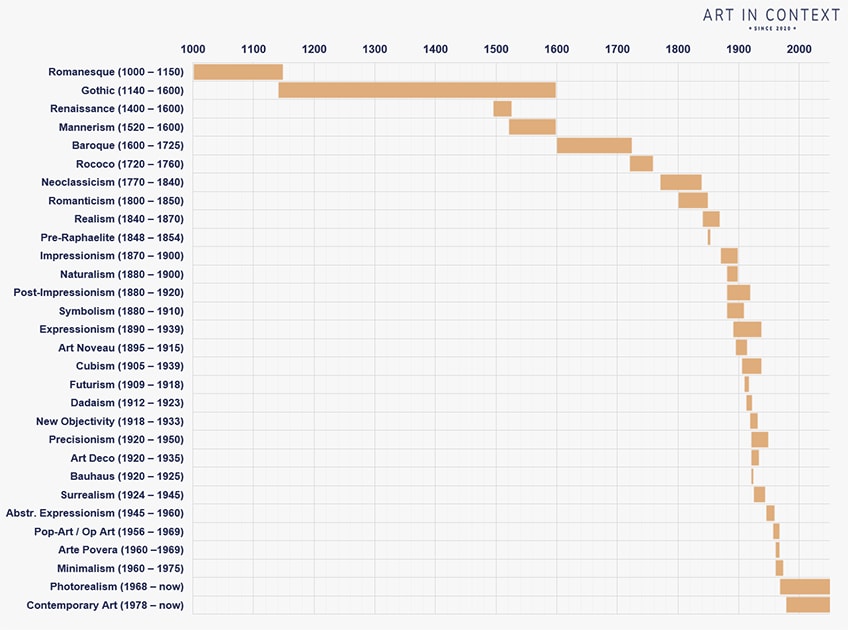
| Art Period | Years |
| Romanesque | 1000 – 1150 |
| Gothic | 1140 – 1600 |
| Renaissance | 1495 – 1527 |
| Mannerism | 1520 – 1600 |
| Baroque | 1600 – 1725 |
| Rococo | 1720 – 1760 |
| Neoclassicism | 1770 – 1840 |
| Romanticism | 1800 – 1850 |
| Realism | 1840 – 1870 |
| Pre-Raphaelite | 1848 – 1854 |
| Impressionism | 1870 – 1900 |
| Naturalism | 1880 – 1900 |
| Post-Impressionism | 1880 – 1920 |
| Symbolism | 1880 – 1910 |
| Expressionism | 1890 – 1939 |
| Fine art Noveau | 1895 – 1915 |
| Cubism | 1905 – 1939 |
| Futurism | 1909 – 1918 |
| Dadaism | 1912 – 1923 |
| New Objectivity | 1918 – 1933 |
| Precisionism | 1920 – 1950 |
| Art Deco | 1920 – 1935 |
| Bauhaus | 1920 – 1925 |
| Surrealism | 1924 – 1945 |
| Abstract Expressionism | 1945 – 1960 |
| Pop-Art / Op Fine art | 1956 – 1969 |
| Arte Povera | 1960 – 1969 |
| Minimalism | 1960 – 1975 |
| Photorealism | 1968 – now |
| Lowbrow Pop Surrealism | 1970 – at present |
| Contemporary Art | 1978 – at present |
It may seem strange for our account of the fine art period timeline to end 30 years agone. The concept of an fine art era seems inadequate to capture the diverseness of creative styles that take grown since the turn of the 21st Century. In that location is a feeling among some art historians that the traditional concept of painting has died in our era of fast-track living. We do not take this stance. Instead, nosotros continue to share our unique man experiences through the medium of art, just as the cave people did, outside of our modern arrangement of classification.
 Biergarten (c. 1915) by Max Liebermann;Max Liebermann, Public domain, via Wikimedia Eatables
Biergarten (c. 1915) by Max Liebermann;Max Liebermann, Public domain, via Wikimedia Eatables
A Comprehensive Art Movement Timeline
It is time to dive a little deeper into the social, cultural, and historical contexts of each of the distinct art eras we presented above. You will encounter how many eras have influence from those earlier them. Fine art, like homo consciousness, is continuously evolving. It is as well important to note that this fine art timeline is a history of Western and predominantly European art.
The Romanesque Period (thousand-1300): Sharing Data Through Art
Art historians typically consider the Romanesque art era to be the start of the art history timeline. Romanesque fine art developed during the rise of Christianity ca. 1000 AD. During this time, only a small percentage of the European population were literate. The ministers of the Christian church were typically part of this minority, and to spread the message of the bible, they needed an alternative method.
Christian objects, stories, deities, saints, and ceremonies were the sectional discipline of virtually Romanesque paintings. Intended to teach the masses well-nigh the values and beliefs of the Christian Church, Romanesque paintings had to exist simple and like shooting fish in a barrel to read.
As a result, Romanesque works of fine art are simple, with assuming contours and make clean areas of color. Romanesque paintings lack whatever depth of perspective, and the imagery is rarely of natural scenes. There were several different forms that Romanesque paintings could accept, including wall paintings, mosaics, console paintings, and book paintings.
Due to the Christian purpose backside Romanesque paintings, they are almost e'er symbolic. The relative importance of the figures within the paintings is shown by the size, with the more important figures appearing much larger. You tin can see that human faces are oft distorted, and the stories depicted in these paintings tend to have a high emotional value. Romanesque paintings often include mythological creatures like dragons and angels, and almost ever appear in churches.
At the most fundamental level, paintings of the Romanesque catamenia serve the purpose of spreading the word of the bible and Christianity. The name of this fine art era stems from circular arches used in Roman architecture, oft constitute in churches of the time.
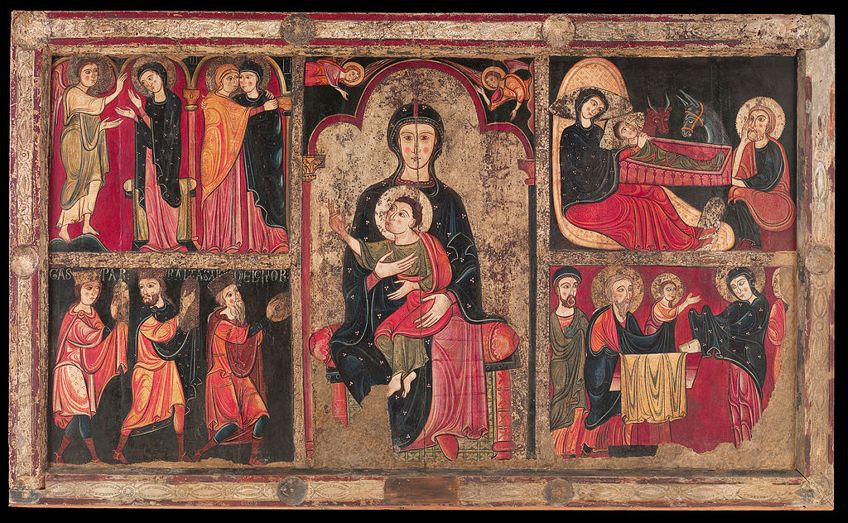 Altar frontal from Avià, c. 1200; Museu Nacional d'Fine art de Catalunya, Public domain, via Wikimedia Eatables
Altar frontal from Avià, c. 1200; Museu Nacional d'Fine art de Catalunya, Public domain, via Wikimedia Eatables
The Gothic Era (1100-1500): Freedom and Fear Come up Together
One of the most famous eras, Gothic fine art grew out of the Romanesque period in French republic and is an expression of two contrasting feelings of the historic period. On the ane hand, people were experiencing and celebrating a new level of freedom of thought and religious agreement. On the other, there was a fright that the world was coming to an terminate. Y'all can clearly see the expression of these two contrasting tensions within the art of the Gothic menstruation.
Simply equally in the Romanesque menstruum, Christianity lay at the heart of the tensions of the Gothic era. Every bit more than freedom of thought emerged, and many pushed against conformity, the subjects of paintings became more diverse. The stronghold of the church began to misemploy.
Gothic paintings portrayed scenes of existent human life, such as working in the fields and hunting. The focus moved abroad from divine beings and mystical creatures as more focus was given to the intricacies of what it meant to be human.
Human figures received a lot more attention during the Gothic period. Gothic artists fleshed out more than realistic human faces as they became more private, less two-dimensional, and less inanimate. The development of a iii-dimensional perspective is thought to accept facilitated this change. Painters also paid more attention to things of personal value similar clothing, which they painted realistically with beautiful folds.
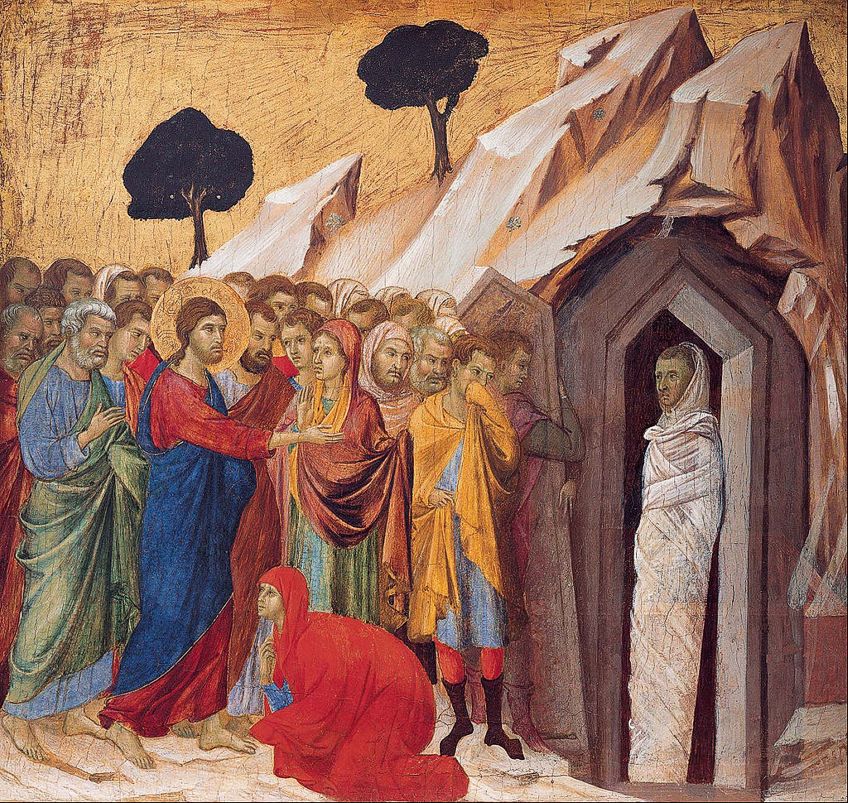 The Raising of Lazarus(1310-1311) by Duccio di Buoninsegna;Duccio di Buoninsegna, Public domain, via Wikimedia Eatables
The Raising of Lazarus(1310-1311) by Duccio di Buoninsegna;Duccio di Buoninsegna, Public domain, via Wikimedia Eatables
Many historians believe that office of the reason why the subjects of fine art became more diverse during the Gothic era was due to the increased surface area for painting within churches. Gothic churches were more expansive than those of the Romanesque catamenia, which is thought to represent the increased feelings of liberty at this time.
Alongside the newfound freedom of artistic expression, there was a deep fear that the end of the earth was coming. It is suggested that this was accompanied by a gradual decline in religion in the church building, and this in plough may have spurred the expansion of art outside of the church. In fact, towards the terminate of the Gothic era, works by Hieronymus von Bosch, Breughel, and others were unsuitable for placement within a church building.
Nosotros do not know many individual artists who painted in the Romanesque period, as art was not nearly who painted information technology but rather the message it carried. Thus, the motion away from the church tin can also be seen in the enormous increase in known artists from the Gothic period, including Giotto di Bondone. Schools of art began to emerge throughout French republic, Italy, Germany, the netherlands, and other parts of Europe.
The Renaissance Era (1420-1520): The Reawakening of an Fine art Era That Never Really Existed
The Renaissance era is possibly one of the most well-known, featuring artists similar Michelangelo and Leonardo da Vinci. This era continued to focus on the individual homo as its inspiration and took influence from the fine art and philosophy of the ancient Romans and Greeks. The Renaissance can be seen as a cultural rebirth.
A part of this cultural rebirth was the returned focus on the natural and realistic world in which humans lived. The three-dimensional perspective became even more of import to the art of the Renaissance, as is aptly demonstrated by Michelangelo's statue ofDavid.This statue harkened back to the works of the ancient Greeks as information technology was consciously created to be seen from all angles. Statues of the last two eras had been two-dimensional, intended to exist viewed only from the front.
 Michelangelo'southward David (1501-1504); Livioandronico2013, CC By-SA iv.0, via Wikimedia Commons
Michelangelo'southward David (1501-1504); Livioandronico2013, CC By-SA iv.0, via Wikimedia Commons
The same 3-dimensional perspective carried over into the paintings of the Renaissance era. Frescos that were invented around 3000 years prior were given new life by Renaissance painters. Scenes became more complex, and the representation of humans became much more nuanced. Renaissance artists painted homo bodies and faces in three dimensions with a strong emphasis on realism. The paint used during the Renaissance flow also represented a shift from tempera paints to oil paints. The Renaissance period is often credited as the very start of great Dutch landscape paintings.
Mannerism (1520-1600): A Window into the Future of Kitsch
Of course, this heading is partly in jest. Not all of the art produced in this era is what nosotros would empathize today as "kitsch". What we understand kitsch to mean today is oftentimes bogus, cheaply made, and without much 'classic' gustatory modality. Instead, the reason we describe the art of this period as being kitsch is due to the relative over-exaggeration that characterized it. Stemming from the newfound liberty of human expression in the Renaissance menstruum, artists began to explore their own unique and private artistic style, or manner.
Michelangelo himself, in fact, is not free from the exaggeration that distinguishes this era. Some art historians practice not consider some of his later paintings to exist works of the Renaissance flow. The expression of feelings and human gestures, fifty-fifty items of clothing, is exaggerated deliberately in mannerist paintings.
The small S-curve of the human body that characterizes the Renaissance style is transformed into an unnatural angle of the torso. This is the beginning European fashion that attracted artists from across Europe to its birthplace in Italy.
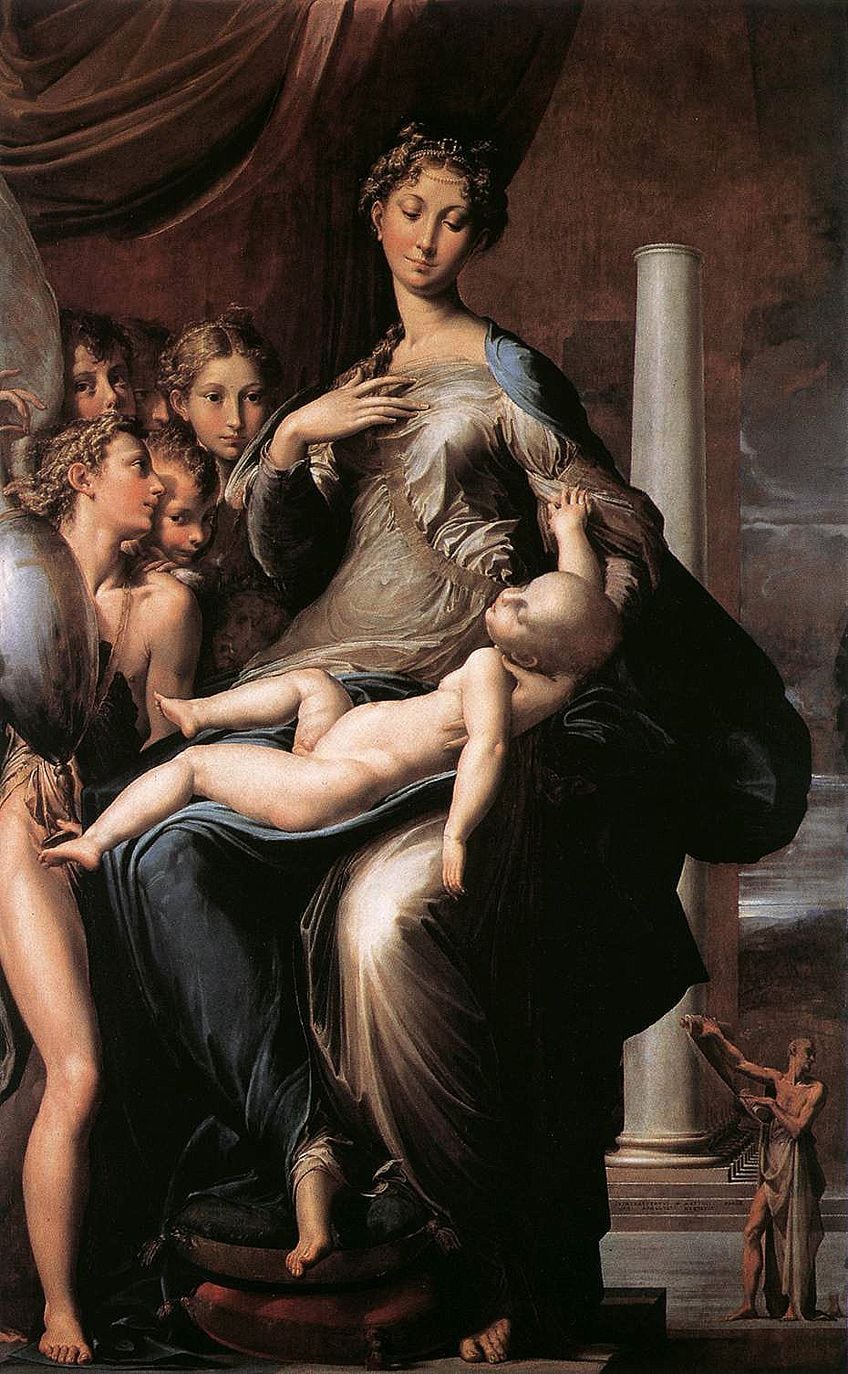 Madonna with Long Cervix (1534-1540) by Parmigianino;Parmigianino, Public domain, via Wikimedia Commons
Madonna with Long Cervix (1534-1540) by Parmigianino;Parmigianino, Public domain, via Wikimedia Commons
The Baroque Era (1590-1760): The Glorification of Power and the Deception of the Eye
The progression of art celebrating the lives of humans over the power of the divine continued into the Bizarre era. Kings, princes, and fifty-fifty popes began to prefer to run into their own power and prestige historic through art than that of God. The over-exaggeration that classified Mannerism also continued into the Baroque menstruum, with the scenes of paintings condign increasingly unrealistic and magnificent.
Baroque paintings often showed scenes where Kings would be ascending into the heavens, mingling with the angels, and reaching ever closer to the divinity and ability of God. Here, nosotros actually can come across the progression of human self-importance, and although the field of study thing does non move away entirely from religious symbolism, man is increasingly the fundamental ability within the compositions.
New materials that glorify wealth and condition similar gold and marble become the prized materials for sculptures. Opposites of light and dark, warm and cold colors, and symbols of proficient and evil are emphasized beyond what is naturally occurring. Art academies increased in their numbers, equally art became a way to display your wealth, ability, and condition.
 Baroque ceiling frescoes of Cathedral in Ljubljana, Slovenia. Piece of work of Italian master Giulio Quaglio in 1703–1706 and after 1721–1723;Petar Milošević, CC Past-SA 4.0, via Wikimedia Eatables
Baroque ceiling frescoes of Cathedral in Ljubljana, Slovenia. Piece of work of Italian master Giulio Quaglio in 1703–1706 and after 1721–1723;Petar Milošević, CC Past-SA 4.0, via Wikimedia Eatables
The Rococo Art Period (1725-1780): Lite and Airy, a French Fancy
The paintings from the Rococo era are typical of the French aristocracy of the time. The proper name stems from the French word rocaille which means "shellwork". The solid forms which characterized the Baroque menstruum softened into light, air, and desire. Paintings of this era were no longer strong and powerful, merely light and playful.
The colors were lighter and brighter, about transparent in some instances. Many pieces of fine art from this period neglected religious themes, although some artists like Tiepolo did create frescos in many churches.
Much like the attitude of the French aristocracy of the time, the art of the Rococo catamenia is totally removed from the social reality. The shepherd's idyll became the theme of this period, representing life as light and carefree, without the constraints of economic or social hardship.
Classicism (1770-1840): Throwing It Back to Archetype Times
Classicism, like the Rococo era, began in French republic in around 1770. In contrast to the Rococo era, however, Classism reverted to earlier, more serious styles of creative expression. Much like the Renaissance period, Classisim took inspiration from classic Roman and Greek art.
The art created in the Classicism era reverted to strict forms, 2-dimensional colors, and homo figures. The tone of these paintings was undoubtedly strict. Colors lost their symbolism. The fine art produced in this era was used internationally to instill feelings of patriotism in the people of each nation. Parts of Classicism include Louis-Sieze, Empire, and Biedermeier.
 A Babyhood Idyll (1900) past William Bouguereau;William-Adolphe Bouguereau, Public domain, via Wikimedia Eatables
A Babyhood Idyll (1900) past William Bouguereau;William-Adolphe Bouguereau, Public domain, via Wikimedia Eatables
Romanticism (1790-1850): A Break from the Severity of it All
You lot can see from the dates that this art era occurred at around the same fourth dimension equally Classicism. Romanticism is often seen every bit an emotionally charged reaction to the stern nature of Classicism. In contrast to the strict and realistic nature of the Classicism era, the paintings of the Romantic era were much more sentimental.
The exploration of the intangible; emotions and the subconscious, took eye-stage. Effectually this fourth dimension, people began to go hiking in an attempt to explore the natural world. It was not, however, the truthful reality of the natural world which they intended to discover, but the way it made them feel.
In that location is no tangible or precisely determinable style to the art of the Romanticism menstruation. English and French painters tended to focus on the furnishings of shadows and lights, while the art produced past High german painters tended to have more than gravity of thought to them. The Romantic painters were oftentimes criticized and even mocked for their interpretation of the world effectually them.
Realism (1850-1925): Objectivity over Subjectivity
As the Romanticism era was a reactionary movement to the Classicism period before it, so is Realism a reaction to Romanticism. In contrast to the beautiful and deeply emotional content of Romantic paintings, Realist artists presented both the expert and beautiful, the ugly and evil. The reality of the world is presented in an unembellished manner by Realism painters.
These artists attempt to show the earth, people, nature, and animals, every bit they truly are. At that place is a focus on the "obligation of art into truth" as Gustave Courbet puts information technology.
But as with Romanticism, Realism was not pop with everyone. The paintings are not particularly pleasing to the centre and some critics have commented that despite the artist's claims of realism, erotic scenes somehow miss the real eroticism. Goethe criticizes Realism, saying that art should exist platonic, not realistic. Schiller besides calls Realism "mean," indicating the harshness that many of the paintings portray.
 Proudhon and His Children(1865) past Gustave Courbet; Gustave Courbet, Public domain, via Wikimedia Eatables
Proudhon and His Children(1865) past Gustave Courbet; Gustave Courbet, Public domain, via Wikimedia Eatables
Impressionism (1850-1895): Heralding the Era of Modern Art
Historians often paint the Impressionist movement as the beginning of the modern age. Impressionist art is said to take closed the book on classical music and other classical forms of art. Impressionism is also perhaps, later on Cubism, one of the nearly easily recognizable art periods. Featuring artists similar Claude Monet and Vincent van Gough, Impressionism broke away from the polish brush strokes and areas of solid color that characterized many art periods before it.
Initially, the word Impressionism was similar a swear word in the art world, with critics assertive that these artists did non paint with technique, merely rather simply smeared pigment onto a canvass. The brushstrokes indeed were a significant deviation from those that came before them, sometimes condign furiously wild. Singled-out shapes and lines disappeared into a whirlwind of colors. Individual dots of completely new colors were put together, particularly in the pointillism variety of Impressionist paintings. The subjects of Impressionist paintings could often only exist recognized from a altitude.
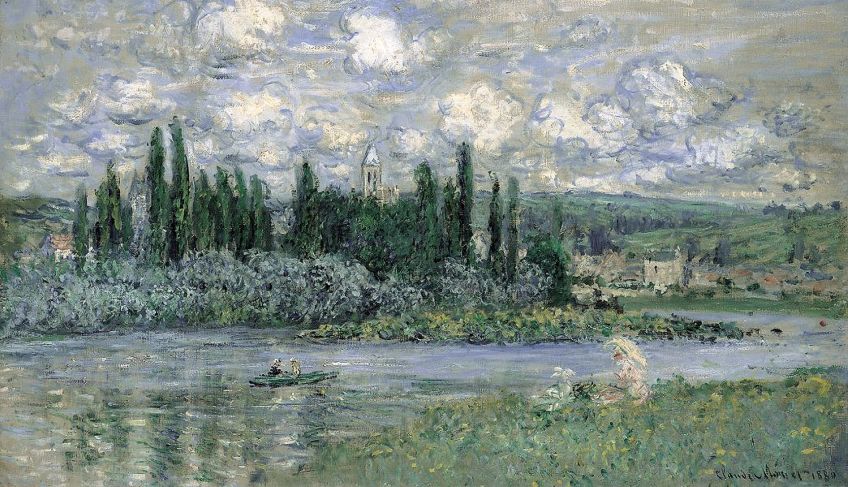 View of Vetheuil sur Seine(1880) past Claude Monet;Claude Monet, Public domain, via Wikimedia Commons
View of Vetheuil sur Seine(1880) past Claude Monet;Claude Monet, Public domain, via Wikimedia Commons
A significant alter that occurred during the Impressionist era was that painting began to take place "en-plein-air," or outside. Much of the Impressionist creative person's ability to capture the complex and ever-changing colors of the natural world were a issue of this shift.
Impressionist artists also began to move away from the want to lecture and teach, preferring to create art for art'due south sake. Galleries and international exhibitions became increasingly important.
Symbolism (1890-1920): There is Ever More Than Meets the Eye
During this menses, the era of Symbolism began to accept hold in French republic. Artists became preoccupied with the representation of feelings and thoughts through objects. The favorite themes of the Symbolism movement were death, sickness, sin, and passion. The forms were by and large clear, a fact which art historians believe was anticipating the Fine art Nouveau era.
Art Nouveau (1890-1910): The Pure Gilded of Gustav Klimt
Although Gustav Klimt was past no means the most important artist in the Fine art Nouveau movement, he is one of the most well-known. His style perfectly encapsulates the Fine art Nouveau movement with soft, curved lines, lots of florals, and the stylistic label of homo figures. In many countries, this mode is known every bit the Secession way.
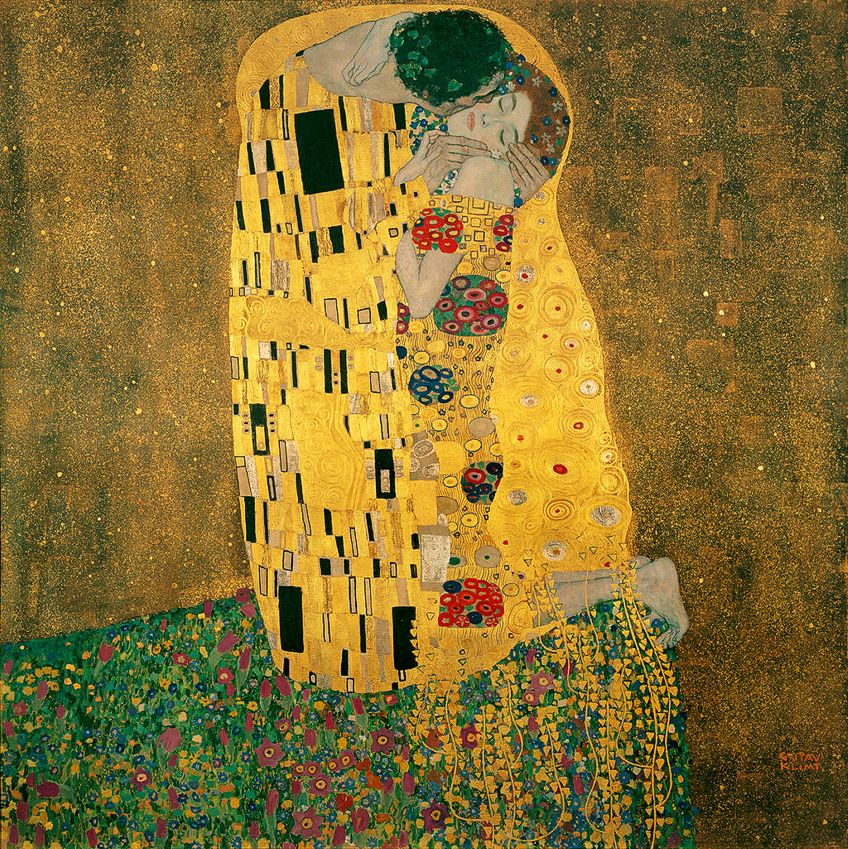 The Kiss (1907-1908) by Gustav Klimt;Gustav Klimt, Public domain, via Wikimedia Eatables
The Kiss (1907-1908) by Gustav Klimt;Gustav Klimt, Public domain, via Wikimedia Eatables
The art produced in the Art Nouveau period includes a lot of symmetry and is characterized past playfulness and youthfulness. Art Nouveau has a lot of political content, although many critics ignore this and hold the decorative aspects against it. Through the art of the Art Nouveau menstruation, artists attempted to bring nature dorsum into industrial cities.
Expressionism (1890-1914): Bringing a Political Edge to the Argue
In the Expressionism art era, we once again see a resurgence of the importance of the expression of subjective feelings. The artists within this movement were not interested in naturalism or what things look like on the outside. As a outcome, at that place is a certain tinge of aggression in some Expressionist paintings, which are oft archaic and slightly wild.
Expressionism originated in Germany and is intended to contrast Impressionism. Towards the get-go of the Start World War, Expressionist paintings had a disturbing intensity about them. Intended to criticize power and the continuing social order, Expressionism spread these political ideas through the medium of pigment. Art was beginning to become political.
Cubism (1906-1914): Breaking Things Apart and Putting Them Back Together Again
Beginning with two artists, Pablo Picasso and Georges Braque, the Cubist movement was all about fragmentation, geometric shapes, and multiple perspectives. The dimensional planes of everyday objects were broken down into unlike geometric segments and put back together in a way that presented the object from multiple sides simultaneously.
Cubism was a rejection of all the rules of traditional western painting and has had a stiff influence on the styles of fine art that have followed information technology.
 Guitar and Glasses (1912) past Juan Gris;Juan Gris, Public domain, via Wikimedia Commons
Guitar and Glasses (1912) past Juan Gris;Juan Gris, Public domain, via Wikimedia Commons
Futurism (1909-1945): Creative Anarchism
Futurism is less of an artistic style and more than of an artistically inspired political movement. Founded by Tommaso Marinetti'sFuturist Manifesto, which rejected social organization and Christian morality, the Futurist era was full of chaos, hostility, aggression, and anger. Although Marinetti was not a painter himself, painting became the most prominent form of art inside the Futurist movement.
These artists vehemently rejected the rules of Classical painting, assertive that everything that was passed through generations (beliefs, traditions, religion) was suspicious and dangerous. The militant nature of the Futurist move has resulted in many people believing that it was too close to fascism.
Dadaism (1912-1920): The True Reality That Life is Nonsense
Dada means a keen many things and nothing at all. The writer Hugo Brawl discovered that this small give-and-take has several different meanings in different languages and at the aforementioned fourth dimension, as a word, it meant nothing at all. The Dadaism movement is based on the concepts of illogic and provocation and was seen as not merely an art move, only an anti-war motility.
The illogic of existing rules, norms, traditions, and values was called into question by the Dadaist motility. The art movement encompassed several art forms including writing, poetry, trip the light fantastic toe, and performance art. Function of the motility was to call into question what could be classified equally "art".
Dadaism represents the beginnings of action art in which painting becomes more than simply a portrait of reality, simply rather an amalgamation of the social, cultural, and subjective parts of being human being.
Surrealism (1920-1930): Things Only Go More Bizzare
Equally if the pure illogic nature of the Dadaism movement was not outlandish enough, the Surrealists took the dream world to be the fountain of all truth. 1 of the most famous Surrealist artists is Salvador Dali, and you lot are bound to know his painting Melting Watch (1954).
Surrealism is fundamentally psychoanalytical, and many Surrealist artists would paint directly from their dreams. Sometimes dealing with uncomfortable concepts, hidden desires, and taboos, Surrealism was a direct critique of the ingrained ideas and beliefs of the bourgeoise. As you tin can imagine, this way of art was non popular when information technology began, merely it has greatly influenced the globe of modernistic art.
 Infinite and time (in homage to 50.V. Beethoven) (1974) by Italian painter William Girometti;William Girometti, CC By-SA iii.0, via Wikimedia Commons
Infinite and time (in homage to 50.V. Beethoven) (1974) by Italian painter William Girometti;William Girometti, CC By-SA iii.0, via Wikimedia Commons
The New Objectivity (1925-1965): Cold and Technical
Equally the surrealists were attempting to motility away from the world of physical, physical, and visible objects, the New Objectivity movement turned towards these ideas. Many of the themes within New Objective art were social critiques. The turbulence of the war left many people searching for some kind of order to concord onto, and this tin can be seen clearly in the art of New Objectivity.
The images represented in New Objectivity were often cold, unemotional, and technical, with some favorite subjects being the radio and lightbulbs. As is the case with many modern movements in art, at that place were several different wings to the New Objectivity movement.
Abstract Expressionism (1948-1962): Stepping Away from Europe
Abstract Expressionism is said to be the first art movement to originate outside of Europe. Emerging from Northward America, Abstruse Expressionism focused on color-field painting and action paintings. Rather than using a canvass and a castor, buckets of paint would be poured on the ground, and artists used their fingers to create images.
With well-known artists like Marc Tobey and Jackson Pollock, this art movement was distinct from whatever that came before it. The awarding of the paint was sometimes so thick that the finished slice would have on a form unlike whatever painting earlier it. Abstract Expressionism spread throughout Europe. As with all art, there are always critics, with conservative Americans during the cold war calling it "un-American."
Pop-Fine art (1955-1969): Art is Everything
For the artists of Pop-Fine art, everything in the globe was fine art. From advertisements, tin can cans, toothpaste, and toilets,everythingis fine art. Popular-Art developed simultaneously in the Usa and England and is characterized by uniform blocks of color and clear lines and contours. Painting and graphic art became influenced past photorealism and serial prints. One of the most famous English Pop artists is David Hockney, although simply a few of his lifetime paintings were in this movement.
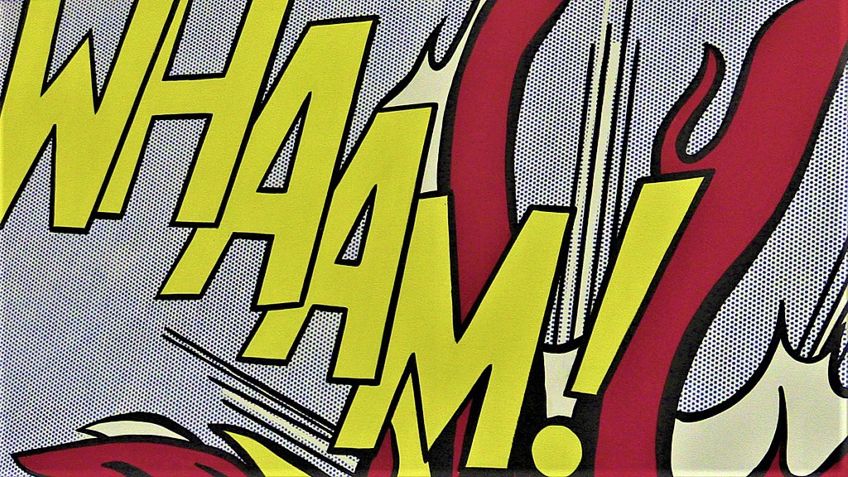 A detail of Roy Lichtenstein's Wall Explosion Two, 1965; Colin McLaughlin, CC BY-SA iv.0, via Wikimedia Commons
A detail of Roy Lichtenstein's Wall Explosion Two, 1965; Colin McLaughlin, CC BY-SA iv.0, via Wikimedia Commons
Neo-Expressionism (1980-1989): Modern Art
Starting in the 1980s, Neo-Expressionism emerged with large-format representational and life-affirming paintings. Berlin was a central point for this new movement, and the designs typically featured cities and big-city life. The name Neo-Expressionism emerged from Fauvism, and although the artists in Berlin disbanded in 1989, some artists continued to pigment in this style in New York.
Art is a cardinal function of what it means to be human. Many of the troubles and joys nosotros experience can only be captured accurately through artistic expression. We promise that this curt summary of the art periods timeline has helped you gain some more insight into the contexts surrounding some of the most famous works of art created by the human race.
We've likewise created a web story nigh art periods.
livingstonwrig1987.blogspot.com
Source: https://artincontext.org/art-periods/